
Features
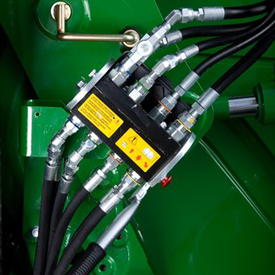 Single-point hydraulic connection on row-crop tractor (closed)
Single-point hydraulic connection on row-crop tractor (closed)
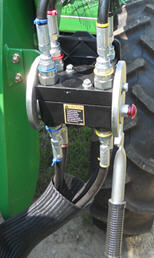 Single-point hydraulic connection on utility tractor (closed)
Single-point hydraulic connection on utility tractor (closed)
The 520M, H240, 540M, H260, and H310 Loaders can be configured with a single-point hydraulic connection that also incorporates the connection point for any electrical needs. To disconnect the hydraulic connection between the loader and the tractor, it is necessary to relieve the hydraulic system oil pressure on the tractor.
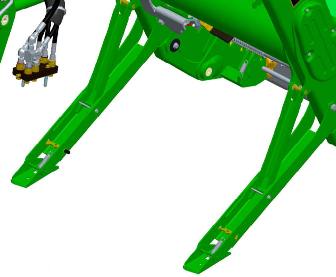 Parking stands
Parking stands

John Deere loaders are easily removed and reinstalled on tractors without tools. The parking system allows removing or attaching the loader to the tractor in minutes without the need for tools.
To remove or park the loader, apply slight down pressure to the loader boom with the bucket dumped at approximately a 30-degree angle. With the tractor in park, lower the parking stands and place the mast pins in the open position.
Removing or parking the loader
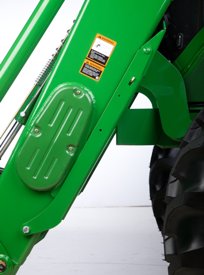 Parking stand in stored position
Parking stand in stored position
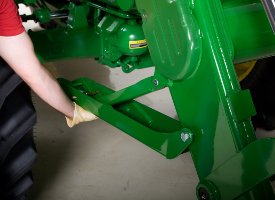 Removing parking stand
Removing parking stand
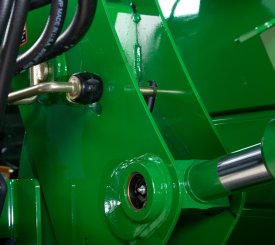 Mast pin in the closed position
Mast pin in the closed position
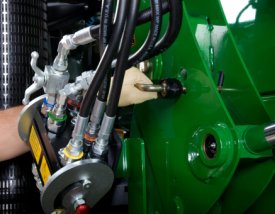 Rotating mast pin to the open position
Rotating mast pin to the open position
Utilizing the boom circuit with the tractor in neutral, rotate the mast forward until the mast has rotated past the pin location on the mounting frame by extending the lift cylinder. Using the bucket circuit, roll back the bucket until the mast is removed from the pocket and will clear the tires.
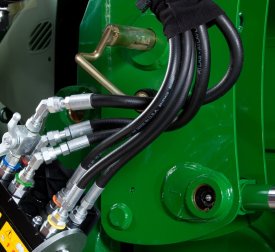 Mast pin in the open position
Mast pin in the open position
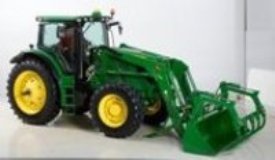 Masts rotate forward, then bucket rolled back
Masts rotate forward, then bucket rolled back
With the tractor in park, shut the engine off and relieve the hydraulic pressure as indicated for the tractor (rotating the joystick). Disconnect or open the single-point hydraulic connector (or remove couplers if no single point is installed).
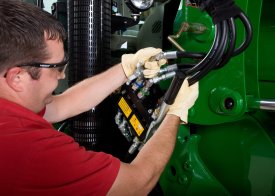 Disconnect/open single-point hydraulic connection
Disconnect/open single-point hydraulic connection
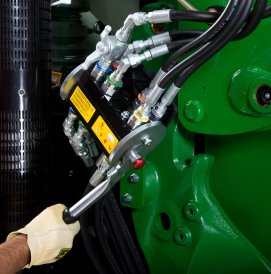 Disconnect/open single-point hydraulic connections
Disconnect/open single-point hydraulic connections
Store the loader half of the single-point connector or hoses, and back away from the loader.
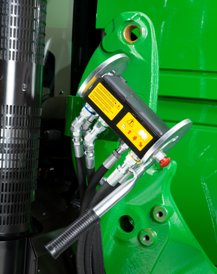 Single-point hydraulics disconnected
Single-point hydraulics disconnected

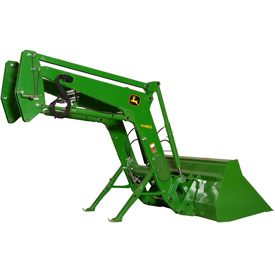 Parked loader
Parked loader
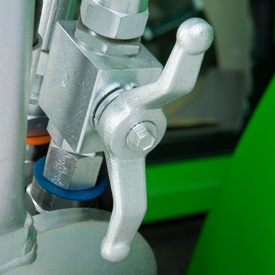 Hydraulic shut-off valve (open position)
Hydraulic shut-off valve (open position)
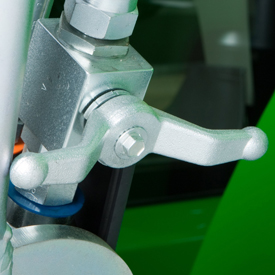 Hydraulic shut-off valve (closed position)
Hydraulic shut-off valve (closed position)
A hydraulic shut-off valve is included with the M- and H-Series Ag Loaders to ensure the loader does not lower suddenly. For example, this allows the boom to be locked out when someone is required to be located under the loader boom for service work on the tractor. It should not be used for extended periods of time unless an appropriate support stand is also utilized.
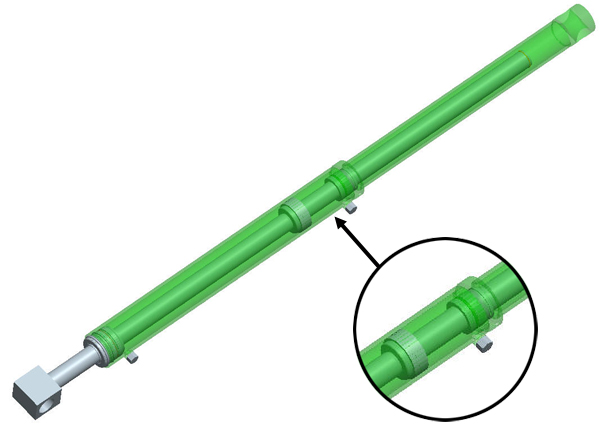 False rod cylinder
False rod cylinder

Fast bucket cycle times are important to dump the load from the bucket as quickly as possible, (quite often) in order to be as productive as possible, while completing loading operations. The bucket cylinder design can have a major impact on this cycle time, especially for the mechanical self-leveling (MSL) loaders.
Therefore, all MSL 520M and H-Series Loaders utilize false rod bucket cylinders. A false rod cylinder has a smaller displacement of oil requirement on the head end of the cylinder, which allows this cylinder to dump much faster than a normal cylinder.
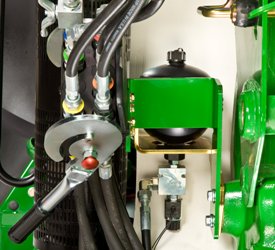 Nitrogen-charged accumulator and electric valve
Nitrogen-charged accumulator and electric valve
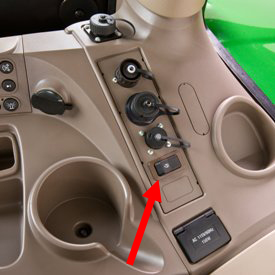 Operator on/off switch
Operator on/off switch
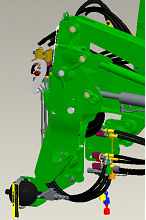 LSS on H180
LSS on H180
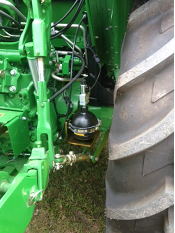 LSS on 5E and 5M
LSS on 5E and 5M
An enhancement to the loader is the suspension system. A great level of loader productivity is achieved with the LSS.
- An accumulator charged with nitrogen and connected to the head-end lift cylinder hose through a T-fitting provides shock absorption
- The cylinders move in and out to allow the boom to float
Performance
- Bales can be transported more efficiently from one end of the field to the other over frozen, hard-packed, or rutted terrain.
NOTE: Check bale-handling capability of tractor before use.
- Pallets can be moved easily without sustaining cargo damage
- Pallets of seed or fertilizer can be carried across a yard without a bag spilling and creating a costly mess
- Properly ballasted tractor with LSS has increased stability, creating a smoother ride for the operator
Cost of ownership
-
Extended life of loader pins and bushings
-
Less stress on tractor axle
Reasons for turning LSS off include:
- Digging applications - with LSS on, the cylinders retract slightly, losing lifting power
- Holding a grade when blading - with LSS on, it is difficult to hold a constant grade
- Precise pallet and bale handling - with LSS on, the load moves up and down slightly while being positioned
- Parking a loader - with LSS on, when down pressure is applied, the lift cylinders retract slightly, making it more difficult to park
The switch is conveniently located in the operator station to avoid having to exit the operator station to manually move the handle on the LSS.
LSS can also be ordered with a manual shutoff. Depending on the tractor/loader model, the accumulator is located in different places. On the H180, the accumulator is mounted outside the bottom of the mounting frame. On the 5 Series Tractors, the accumulator is mounted near the inside of the rear right wheel. On 6 Series Tractors and larger, it is mounted in between the hydraulic connection and the mounting frame.
Specs & Compare
Key Specs | 520M Current Model |
| Maximum lift height | 3352 mm 132 in. |
| Lift capacity at full height | Measured at pivot 1598 kg 3523 lb |
| Boom breakout force | Measured at pivot 2105 kgf 4640.7 lbf |
| Bucket rollback force capacity | At ground-level line 2191 kgf 4830.3 lbf |
| Clearance at full height - bucket dumped | 2520 mm 99.2 in. |
| Dump angle, degrees | -55 degree (angle) |
| Rollback angle, degrees | 44 degree (angle) |
Tractor | |
| Model | 5E Final Tier 4 (FT4) 3-Cyl (5045E, 5055E, 5065E, 5075E) |
| Front tire | 320/85 R24 BKT (12.4 R24) |
| Rear tire | 420/85 R30 BTK (16.9) |
| Front axle configuration | |
| Wheelbase | 81 in. |
| Pump capacity | 11 gpm |
| Rated pressure | 2828 psi |
Loader | |
| Base weight | 906.29 kg |
| Leveling configuration | Non-Self Leveling (NSL) |
| Bucket used | General Purpose 1850 mm 73 in. |
| Bucket weight | 178 kg 392 lb |
| Lift capacity at full height | Measured at pivot 1598 kg 3523 lb Measured at 800 mm ahead of pivot 1040 kg 2292.8 lb |
| Lift capacity at 59 in. (1500 mm) | Measured at pivot 1828 kg 4030 lb Measured at 800 mm ahead of pivot 1349 kg 2974 lb |
| Boom breakout force | Measured at pivot 2105 kgf 4640.7 lbf Measured at 800 mm ahead of pivot 1437 kgf 3168 lbf |
| Bucket rollback force capacity | At maximum height 1209 kgf 2665.4 lbf At 59-in. (1500-mm) lift height 2151 kgf 4742.1 lbf At ground-level line 2191 kgf 4830.3 lbf |
| Dimensions | Maximum lift height 3352 mm 132 in. At full height - bucket level 3157 mm 124.3 in. At full height - bucket dumped 2520 mm 99.2 in. |
| Overall length | 4.3 m 14.1 ft |
| Overall height in carry position | |
| Digging depth | 73 mm 2.9 in. |
| Reach | At maximum height 1038.2 mm 40.9 in. At ground level - bucket level 2248 mm 88.5 in. |
| Bucket angle | Dump angle, degrees -55 degree (angle) Rollback angle, degrees 44 degree (angle) Dump angle, ground -144 degree (angle) |
| Cycle times | Loader raise, seconds 5.1 seconds Loader lower, seconds 3.4 seconds Bucket dump, seconds 4.3 seconds Bucket rollback, seconds 2.6 seconds |
Additional information | |
Offers & Discounts
Accessories & Attachments
Buckets
This general-purpose bucket can be used in numerous applications.
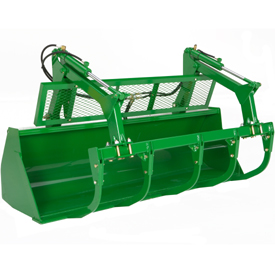 Five-tine round bale/silage grapple with grille
Five-tine round bale/silage grapple with grille

All compatible John Deere Loaders use the same five-tine, pin-on grapple. The advantages of this grapple are:
- The pin-on method puts the least amount of stress possible on the bucket.
- The grapple has a wide stance, making it more difficult to twist.
High-performance operators will choose the five-tine grapple for its increased durability and load-carrying capacity. Advantages include:
- The ability to handle two large round bales instead of one (where loader capacity allows).
- Strong grapple arms allow the bucket capacity to be increased by almost twice the amount of normal bucket capacity in materials such as silage.
The grapple is equipped with twin cylinders to provide excellent clamping force.
NOTE: The center tine of the five-tine grapple is slightly off center to avoid contact with the placement of optional digging teeth.
NOTE: The grapple is not compatible with materials or high-volume buckets.
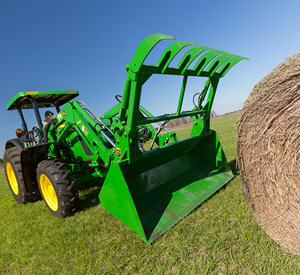 1850-mm (73-in.) bale grapple bucket
1850-mm (73-in.) bale grapple bucket
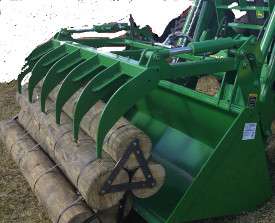 73–in. (1850 mm) grapple bucket BW15358 shown (all one piece
73–in. (1850 mm) grapple bucket BW15358 shown (all one piece
The bale grapple bucket is a complete solution ideal for full loads of silage, handling bales, or cleaning up debris or manure.
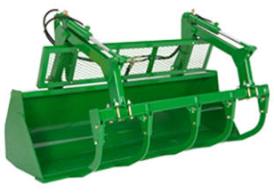 Heavy-duty bucket (shown with grapple)
Heavy-duty bucket (shown with grapple)

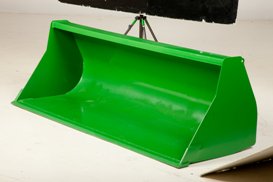 Materials bucket
Materials bucket

Materials buckets may be used for loading dirt, gravel, feed, and light materials as well as scraping, digging, and other general-purpose tasks.
NOTE: Materials buckets are not compatible with replaceable cutting edges or digging teeth.
This general-purpose bucket can be used in numerous applications.
The high-volume bucket is intended for use with lighter-density, high-volume materials. The bucket capacity makes this an effective tool for handling snow, wood shavings, and other loose materials.
 Materials bucket
Materials bucket

Materials buckets may be used for loading dirt, gravel, feed, and light materials as well as scraping, digging, and other general-purpose tasks.
NOTE: Materials buckets are not compatible with replaceable cutting edges or digging teeth.
Carriers
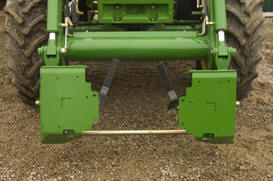 Skid steer carrier
Skid steer carrier
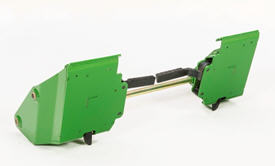 Skid steer carrier
Skid steer carrier
The skid steer attachment carrier allows the use of skid steer-type attachments. One person can quickly change attachments without the use of tools by simply rolling the attachment back, lifting the levers, and then rolling the attachment forward and lowering to the ground.
Hood Guards
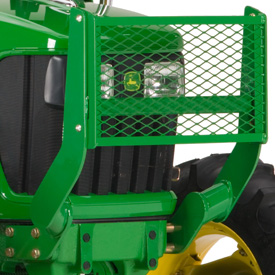 Brush guard
Brush guard
The brush guard is designed for operators who require added protection against debris from damaging the expensive-to-replace front grille or lights.
NOTE: Not compatible with front hitch.
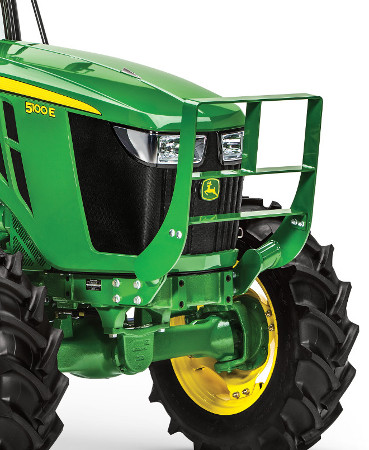 Hood guard on 5100E Tractor
Hood guard on 5100E Tractor

The hood guard’s basic function is to:
- Help protect the tractor's grille and hood from falling debris or stationary objects, such as a barn wall or while loading material into a wagon or mixer.
- Allow for lighting at night
- Provide extra tractor protection (can be used without loader installed)
- Can be used with or without the tractor's front weight bracket but not with the actual front weights while using the loader
It is highly recommended to purchase a front weight bracket when using a loader. The hood guard is designed to be slightly rearward of the front weight. This is so that the front weight is the first point of contact against lower stationary objects.
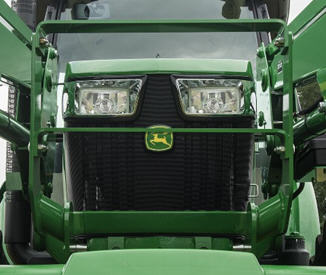 Hood guard on 5E Tractor
Hood guard on 5E Tractor
The basic functions of the hood guard are:
- Help protect the tractor's grille and hood from falling debris or stationary objects, such as a wagon or mixer, while loading
- Allow for lighting at night
- Typically can be used with or without the tractor's front weight bracket but not with the actual front weights while using the loader
- Cannot be used with a front hitch
It is recommended to purchase a front weight bracket when using a loader. The hood guard is designed to be slightly rearward of the front weight. This is so that the front weight is the first point of contact against lower stationary objects.
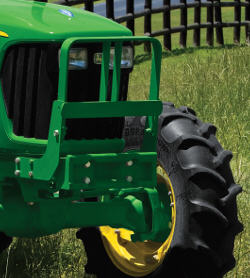 Hood guard on 5 Series Tractor
Hood guard on 5 Series Tractor
The hood guard's basic function is to:
- Help protect the tractor grille and hood from falling debris or stationary objects, such as a wagon or mixer, while loading
- Allow for lighting at night
- Can be used with or without the tractor front weight bracket but not with the actual front weights while using the loader
- Cannot be used with a front hitch
It is highly recommended to purchase a front weight bracket when using a loader. The hood guard is designed to be slightly rearward of the front weight. This is so that the front weight is the first point of contact against lower stationary objects.
 Hood guard on 5E Tractor
Hood guard on 5E Tractor
The basic functions of the hood guard are:
- Help protect the tractor's grille and hood from falling debris or stationary objects, such as a wagon or mixer, while loading
- Allow for lighting at night
- Typically can be used with or without the tractor's front weight bracket but not with the actual front weights while using the loader
- Cannot be used with a front hitch
It is recommended to purchase a front weight bracket when using a loader. The hood guard is designed to be slightly rearward of the front weight. This is so that the front weight is the first point of contact against lower stationary objects.
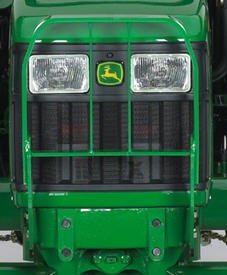 Hood guard on 5 Series Tractor
Hood guard on 5 Series Tractor
The hood guard's basic function is to:
- Help protect the tractor grille and hood from falling debris or stationary objects, such as a wagon or mixer, while loading
- Allow for lighting at night
- Can be used with or without the tractor front weight bracket but not with the actual front weights while using the loader
- Cannot be used with a front hitch
It is highly recommended to purchase a front weight bracket when using a loader. The hood guard is designed to be slightly rearward of the front weight. This is so that the front weight is the first point of contact against lower stationary objects.
 Hood guard on 5 Series Tractor
Hood guard on 5 Series Tractor
The hood guard's basic function is to:
- Help protect the tractor grille and hood from falling debris or stationary objects, such as a wagon or mixer, while loading
- Allow for lighting at night
- Can be used with or without the tractor front weight bracket but not with the actual front weights while using the loader
- Cannot be used with a front hitch
It is highly recommended to purchase a front weight bracket when using a loader. The hood guard is designed to be slightly rearward of the front weight. This is so that the front weight is the first point of contact against lower stationary objects.
 Hood guard on 5E Tractor
Hood guard on 5E Tractor
The basic functions of the hood guard are:
- Help protect the tractor's grille and hood from falling debris or stationary objects, such as a wagon or mixer, while loading
- Allow for lighting at night
- Typically can be used with or without the tractor's front weight bracket but not with the actual front weights while using the loader
- Cannot be used with a front hitch
It is recommended to purchase a front weight bracket when using a loader. The hood guard is designed to be slightly rearward of the front weight. This is so that the front weight is the first point of contact against lower stationary objects.
Hoses and Parts
The loader hoses are connected to the mid-tractor selective control valves (SCVs).
Hydraulic Connection
Two function
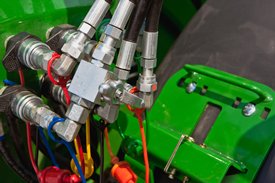 Two function quick coupler
Two function quick coupler

The H240, H260, H310, H340, and H360 Loaders feature two-function quick-couplers in base machine. To disconnect the hydraulic connection between the loader and the tractor, it is necessary to relieve the hydraulic system oil pressure on the tractor.
Three function
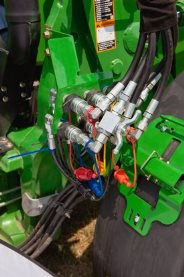 Three function quick coupler
Three function quick coupler
The H240, H260, H310, H340, and H360 Loaders can be equipped with three-function quick-couplers. Hoses will be installed in the boom arm and just the couplers will need to be assembled along with the third-function bracket and oil line. To disconnect the hydraulic connection between the loader and the tractor, it is necessary to relieve the hydraulic system oil pressure on the tractor.
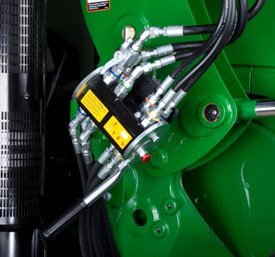 Single-point hydraulic connection on row-crop tractor
Single-point hydraulic connection on row-crop tractor
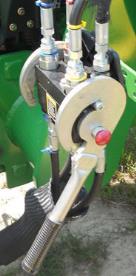 Single-point hydraulic connection on 5E Series Tractor
Single-point hydraulic connection on 5E Series Tractor
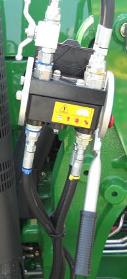 Single-point hydraulic connection on 5M Series Tractor
Single-point hydraulic connection on 5M Series Tractor
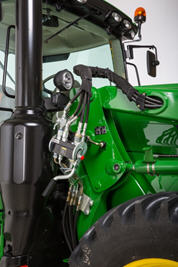 Single-point hydraulic connection on 6R Tractor
Single-point hydraulic connection on 6R Tractor
The 520M, H240, 540M, H260, and H310 Loaders feature a single-point hydraulic connection that also incorporates the connection point for any electrical needs as well. To disconnect the hydraulic connection between the loader and the tractor, it is necessary to relieve the hydraulic system oil pressure on the tractor.
Two function
 Two function quick coupler
Two function quick coupler

The H240, H260, H310, H340, and H360 Loaders feature two-function quick-couplers in base machine. To disconnect the hydraulic connection between the loader and the tractor, it is necessary to relieve the hydraulic system oil pressure on the tractor.
Three function
 Three function quick coupler
Three function quick coupler
The H240, H260, H310, H340, and H360 Loaders can be equipped with three-function quick-couplers. Hoses will be installed in the boom arm and just the couplers will need to be assembled along with the third-function bracket and oil line. To disconnect the hydraulic connection between the loader and the tractor, it is necessary to relieve the hydraulic system oil pressure on the tractor.
 Single-point hydraulic connection on row-crop tractor
Single-point hydraulic connection on row-crop tractor
 Single-point hydraulic connection on 5E Series Tractor
Single-point hydraulic connection on 5E Series Tractor
 Single-point hydraulic connection on 5M Series Tractor
Single-point hydraulic connection on 5M Series Tractor
 Single-point hydraulic connection on 6R Tractor
Single-point hydraulic connection on 6R Tractor
The 520M, H240, 540M, H260, and H310 Loaders feature a single-point hydraulic connection that also incorporates the connection point for any electrical needs as well. To disconnect the hydraulic connection between the loader and the tractor, it is necessary to relieve the hydraulic system oil pressure on the tractor.
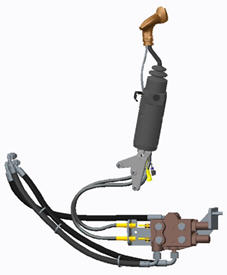 BSJ10346 – 5E Tractor mid selective control valve (SCV) field install kit (FIK) with third-function joystick
BSJ10346 – 5E Tractor mid selective control valve (SCV) field install kit (FIK) with third-function joystick
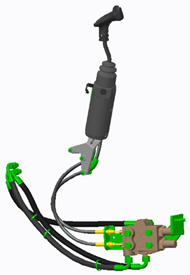 BSJ10262 – tractor mid SCV FIK with two-function joystick
BSJ10262 – tractor mid SCV FIK with two-function joystick
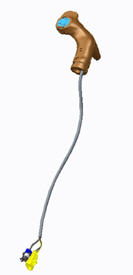 LVA13698 –FIK joystick to convert mid SCV without diverter option to a diverter option
LVA13698 –FIK joystick to convert mid SCV without diverter option to a diverter option
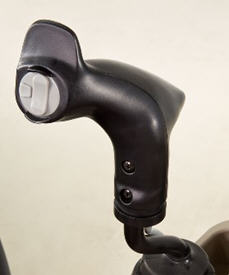 Joystick
Joystick
The 520M Loader has a diverter kit for field installation that allows for third-function usage on 5E 3-Cylinder Tractor model year 2018 and newer. This kit is a complete solution for a two-function 520M Loader to become third-function operational. The diverter kit is installed under the loader torque tube assembly to prevent damage and debris collection. A third-function joystick allows for 2 function + 1 function during operation. The operator engages the third function on the joystick which sends a signal to the diverter to switch hydraulic flow away from a second function and activates third function. The previous function will no longer be operational until the third is released.
Tractor dual mid-valve is a required option for the diverter to be compatible.

NOTE: Will require either a factory- or field-installed tractor dual mid-valve kit. Field-installed bundles are BSJ10262 (dual mid-valve kit with two-function joystick) or BSJ10346 (dual mid-valve kit with third-function joystick).
NOTE: If installing a diverter kit on a tractor with a field-installed dual mid-valve (bundle BSJ10346), the third-function joystick (LVA13698) is already included. Only order BXX10199 or BXX10198.
NOTE: If installing a diverter kit on a tractor with a factory-installed dual mid-valve or field-installed dual mid-valve (bundle BSJ10262), order diverter kit BXX10199 or BXX10198 and joystick LVA13698 from Parts.
 BSJ10346 – 5E Tractor mid selective control valve (SCV) field install kit (FIK) with third-function joystick
BSJ10346 – 5E Tractor mid selective control valve (SCV) field install kit (FIK) with third-function joystick
 BSJ10262 – tractor mid SCV FIK with two-function joystick
BSJ10262 – tractor mid SCV FIK with two-function joystick
 LVA13698 –FIK joystick to convert mid SCV without diverter option to a diverter option
LVA13698 –FIK joystick to convert mid SCV without diverter option to a diverter option
 Joystick
Joystick
The 520M Loader has a diverter kit for field installation that allows for third-function usage on 5E 3-Cylinder Tractor model year 2018 and newer. This kit is a complete solution for a two-function 520M Loader to become third-function operational. The diverter kit is installed under the loader torque tube assembly to prevent damage and debris collection. A third-function joystick allows for 2 function + 1 function during operation. The operator engages the third function on the joystick which sends a signal to the diverter to switch hydraulic flow away from a second function and activates third function. The previous function will no longer be operational until the third is released.
Tractor dual mid-valve is a required option for the diverter to be compatible.

NOTE: Will require either a factory- or field-installed tractor dual mid-valve kit. Field-installed bundles are BSJ10262 (dual mid-valve kit with two-function joystick) or BSJ10346 (dual mid-valve kit with third-function joystick).
NOTE: If installing a diverter kit on a tractor with a field-installed dual mid-valve (bundle BSJ10346), the third-function joystick (LVA13698) is already included. Only order BXX10199 or BXX10198.
NOTE: If installing a diverter kit on a tractor with a factory-installed dual mid-valve or field-installed dual mid-valve (bundle BSJ10262), order diverter kit BXX10199 or BXX10198 and joystick LVA13698 from Parts.
Loader Suspension System
 Nitrogen-charged accumulator and electric valve
Nitrogen-charged accumulator and electric valve
 Operator on/off switch
Operator on/off switch
 LSS on H180
LSS on H180
 LSS on 5E and 5M
LSS on 5E and 5M
An enhancement to the loader is the suspension system. A great level of loader productivity is achieved with the LSS.
- An accumulator charged with nitrogen and connected to the head-end lift cylinder hose through a T-fitting provides shock absorption
- The cylinders move in and out to allow the boom to float
Performance
- Bales can be transported more efficiently from one end of the field to the other over frozen, hard-packed, or rutted terrain.
NOTE: Check bale-handling capability of tractor before use.
- Pallets can be moved easily without sustaining cargo damage
- Pallets of seed or fertilizer can be carried across a yard without a bag spilling and creating a costly mess
- Properly ballasted tractor with LSS has increased stability, creating a smoother ride for the operator
Cost of ownership
-
Extended life of loader pins and bushings
-
Less stress on tractor axle
Reasons for turning LSS off include:
- Digging applications - with LSS on, the cylinders retract slightly, losing lifting power
- Holding a grade when blading - with LSS on, it is difficult to hold a constant grade
- Precise pallet and bale handling - with LSS on, the load moves up and down slightly while being positioned
- Parking a loader - with LSS on, when down pressure is applied, the lift cylinders retract slightly, making it more difficult to park
The switch is conveniently located in the operator station to avoid having to exit the operator station to manually move the handle on the LSS.
LSS can also be ordered with a manual shutoff. Depending on the tractor/loader model, the accumulator is located in different places. On the H180, the accumulator is mounted outside the bottom of the mounting frame. On the 5 Series Tractors, the accumulator is mounted near the inside of the rear right wheel. On 6 Series Tractors and larger, it is mounted in between the hydraulic connection and the mounting frame.
 Nitrogen-charged accumulator and electric valve
Nitrogen-charged accumulator and electric valve
 Operator on/off switch
Operator on/off switch
 LSS on H180
LSS on H180
 LSS on 5E and 5M
LSS on 5E and 5M
An enhancement to the loader is the suspension system. A great level of loader productivity is achieved with the LSS.
- An accumulator charged with nitrogen and connected to the head-end lift cylinder hose through a T-fitting provides shock absorption
- The cylinders move in and out to allow the boom to float
Performance
- Bales can be transported more efficiently from one end of the field to the other over frozen, hard-packed, or rutted terrain.
NOTE: Check bale-handling capability of tractor before use.
- Pallets can be moved easily without sustaining cargo damage
- Pallets of seed or fertilizer can be carried across a yard without a bag spilling and creating a costly mess
- Properly ballasted tractor with LSS has increased stability, creating a smoother ride for the operator
Cost of ownership
-
Extended life of loader pins and bushings
-
Less stress on tractor axle
Reasons for turning LSS off include:
- Digging applications - with LSS on, the cylinders retract slightly, losing lifting power
- Holding a grade when blading - with LSS on, it is difficult to hold a constant grade
- Precise pallet and bale handling - with LSS on, the load moves up and down slightly while being positioned
- Parking a loader - with LSS on, when down pressure is applied, the lift cylinders retract slightly, making it more difficult to park
The switch is conveniently located in the operator station to avoid having to exit the operator station to manually move the handle on the LSS.
LSS can also be ordered with a manual shutoff. Depending on the tractor/loader model, the accumulator is located in different places. On the H180, the accumulator is mounted outside the bottom of the mounting frame. On the 5 Series Tractors, the accumulator is mounted near the inside of the rear right wheel. On 6 Series Tractors and larger, it is mounted in between the hydraulic connection and the mounting frame.
Mounting Frames
![5E 4- Ccylinder (Interim Tier 4 [IT4]; 5100E) mounting frame](https://salesmanual.deere.com/sales/salesmanual/images/NA/materialhandling/features_attachment/h310/5e_4_cyl_frame.jpg) 5E 4- Ccylinder (Interim Tier 4 [IT4]; 5100E) mounting frame
5E 4- Ccylinder (Interim Tier 4 [IT4]; 5100E) mounting frame
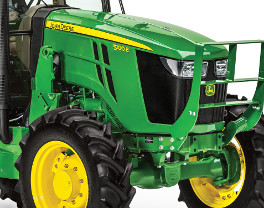 5E 4-cylinder loader prep package shown with tractor factory-installed loader mounting frames and hood guard
5E 4-cylinder loader prep package shown with tractor factory-installed loader mounting frames and hood guard
Mounting frames are designed to evenly distribute forces during loader operation. Hardware is accessible to torque to the correct specifications.
![5E 4- Ccylinder (Interim Tier 4 [IT4]; 5100E) mounting frame](https://salesmanual.deere.com/sales/salesmanual/images/NA/materialhandling/features_attachment/h310/5e_4_cyl_frame.jpg) 5E 4- Ccylinder (Interim Tier 4 [IT4]; 5100E) mounting frame
5E 4- Ccylinder (Interim Tier 4 [IT4]; 5100E) mounting frame
 5E 4-cylinder loader prep package shown with tractor factory-installed loader mounting frames and hood guard
5E 4-cylinder loader prep package shown with tractor factory-installed loader mounting frames and hood guard
Mounting frames are designed to evenly distribute forces during loader operation. Hardware is accessible to torque to the correct specifications.
![5E 4- Ccylinder (Interim Tier 4 [IT4]; 5100E) mounting frame](https://salesmanual.deere.com/sales/salesmanual/images/NA/materialhandling/features_attachment/h310/5e_4_cyl_frame.jpg) 5E 4- Ccylinder (Interim Tier 4 [IT4]; 5100E) mounting frame
5E 4- Ccylinder (Interim Tier 4 [IT4]; 5100E) mounting frame
 5E 4-cylinder loader prep package shown with tractor factory-installed loader mounting frames and hood guard
5E 4-cylinder loader prep package shown with tractor factory-installed loader mounting frames and hood guard
Mounting frames are designed to evenly distribute forces during loader operation. Hardware is accessible to torque to the correct specifications.
![5E 4- Ccylinder (Interim Tier 4 [IT4]; 5100E) mounting frame](https://salesmanual.deere.com/sales/salesmanual/images/NA/materialhandling/features_attachment/h310/5e_4_cyl_frame.jpg) 5E 4- Ccylinder (Interim Tier 4 [IT4]; 5100E) mounting frame
5E 4- Ccylinder (Interim Tier 4 [IT4]; 5100E) mounting frame
 5E 4-cylinder loader prep package shown with tractor factory-installed loader mounting frames and hood guard
5E 4-cylinder loader prep package shown with tractor factory-installed loader mounting frames and hood guard
Mounting frames are designed to evenly distribute forces during loader operation. Hardware is accessible to torque to the correct specifications.
![5E 4- Ccylinder (Interim Tier 4 [IT4]; 5100E) mounting frame](https://salesmanual.deere.com/sales/salesmanual/images/NA/materialhandling/features_attachment/h310/5e_4_cyl_frame.jpg) 5E 4- Ccylinder (Interim Tier 4 [IT4]; 5100E) mounting frame
5E 4- Ccylinder (Interim Tier 4 [IT4]; 5100E) mounting frame
 5E 4-cylinder loader prep package shown with tractor factory-installed loader mounting frames and hood guard
5E 4-cylinder loader prep package shown with tractor factory-installed loader mounting frames and hood guard
Mounting frames are designed to evenly distribute forces during loader operation. Hardware is accessible to torque to the correct specifications.
Videos
© COPYRIGHT 2025 SMITH TRACTOR CO. EQUIPMENT - ALL RIGHTS RESERVED| Privacy Policy | Powered By













